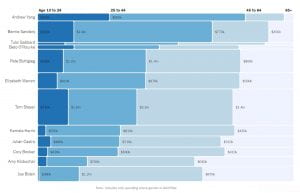How do targeted ads affect voter decision?
The 19 democratic candidates for the 2020 election have collectively spent a total of $32 million on targeted Facebook ads, which was more than that was spent on TV ads, a signal of the social network’s rising influence. The 2020 race is the first presidential campaign where Facebook is publicly publishing who bought the ad who they are targeted towards. Since these ads allow for real-time feedback, campaigners can optimize their ads towards the people who are taking the action that the campaigners want them to take. Bernie Sanders has spent $500k on ads targeted to voters from ages 13-24, whereas Joe Biden has only spent $12k. See the chart below for more detailed breakdowns. Democratic candidates are targeting the demographic groups that show prominent support in the polls. This is the best strategy since much of the advertising spent so far is towards encouraging donations. Facebook’s algorithm encourages advertisers to target whatever demographic groups that are already clicking on the ads, which push the candidates with older bases to target more older audiences, and the candidates with younger bases to target more younger audiences. Digital strategists say that there are three phases in online advertising for campaigns. The first is acquiring new donors and supporters. The second is persuading undecided voters. The third is getting people out to vote. Most Democratic candidates are focusing on the first phase but there is a noticeable shift to the second phase that is starting to occur. While the Democrats are focusing on the primary elections, Donald Trump is targeting ads towards the general election. Last month, he spent more than $700k on Facebook ads in Michigan, Pennsylvania, Wisconsin and Florida, the four swing states he narrowly won over in 2016.
Source: https://www.nytimes.com/interactive/2019/10/14/us/politics/democrats-political-facebook-ads.html
But how do ad campaigns actually affect voters’ decisions? Today, voters increasingly depend on mobile devices to obtain more information about a candidate, issue, or event. It is through “micro-moments” that affect voters’ decisions- the small instances that occur whenever voters turn towards their smartphones to find more information about anything. They often turn to YouTube to catch up on the latest elections news. “Since April 2015, people have watched more than 110 million hours of candidate- and issues-related content on YouTube. That’s 100X the amount of time it would take to watch all content ever aired on CNN, C-Span, MSNBC, and Fox News combined.” The YouTube demographic isn’t just young people, however. While 60% of people who watch election related content are under the age of 35, 25% are over 45. So this makes YouTube a good platform for candidates to present their views on topics as it’s the first source of information that voters will turn towards, and the demographic audience is fairly wide. With Google Trends, candidates can understand what issues that voters care most deeply about. Refugees is the most prominent issue, with a 224% increase in searches. In addition to tailoring ads based on popular topics, candidates can also analyze how many people actually watch the ad or decide to skip over them with YouTube’s True View “skip” button. Content is important, but when it happens is also important. With YouTube Analytics, candidates can visualize when viewers are collectively showing interest in a certain topic with increasing spikes in total watch time. This way, they can tailor their content and when they release it. The subject and timing of advertisements are important, but it is probably not more convincing than your favorite celebrity’s endorsement. YouTube content creators carry an immense amount of influence, more than half of daily YouTube users say their personal opinions have been affected by YouTube creators. The most successful YouTubers become famous because they know their audience better than anyone else to be able to construct content tailored for them. The most influential candidate will win through this method, too- by knowing who their audience is, what they want, and when they should hear it.
Source: https://www.thinkwithgoogle.com/marketing-resources/content-marketing/political-ads-video-content-influence-voter-opinion/

